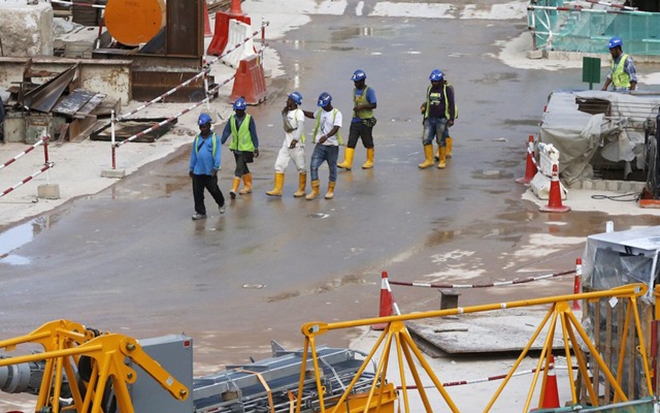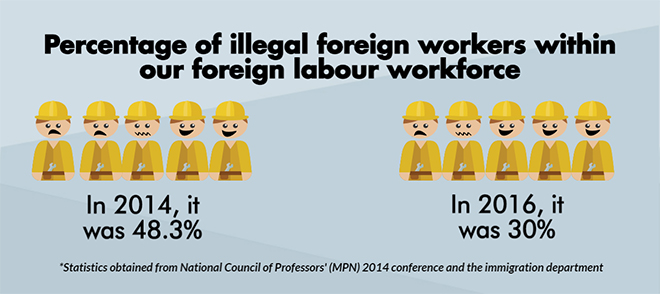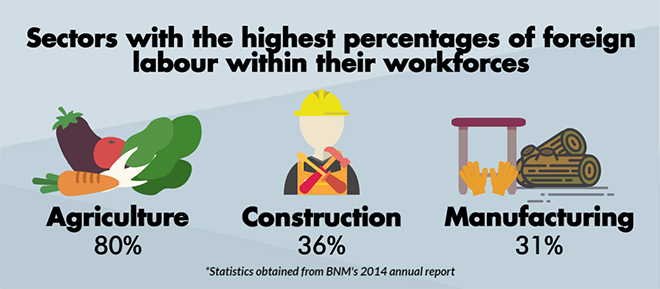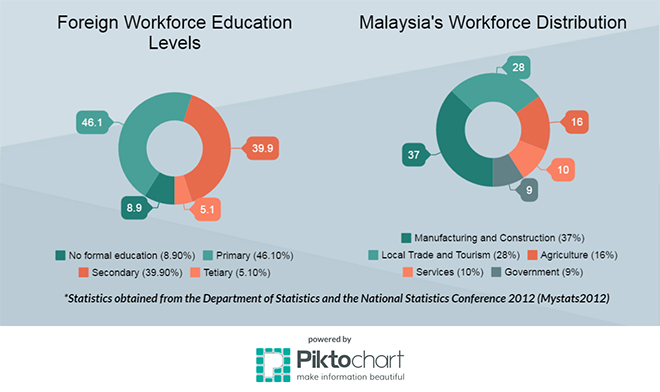 KUCHING: As the sun peeks up above the horizon, a trail of reflective vests and white hardhats are seen trudging along a muddy path leading to a sprawling construction site.
KUCHING: As the sun peeks up above the horizon, a trail of reflective vests and white hardhats are seen trudging along a muddy path leading to a sprawling construction site.
The massive unfinished structure towering above the residential houses nearby seems to have appeared overnight as only a few short months ago the land was barren.
The ones responsible for this rapid progress are the owners of the worn safety gear, a band of weary foreign workers who have worked tirelessly over the past few months from dawn to dusk to meet the construction deadlines, fuelled only by nicotine and cheap hawker food.
As the workers arrive to their workplace, without a word, they head on to their allocated areas and picked up where they left off yesterday.
They work diligently, efficiently and independently with an ethic cultivated over the years from their extensive experience in laboured work, fuelled by dreams of a better life back home in their countries.
Such a scenario is common at any construction site around the country. Foreign workers make up a crucial component to the backbone of a construction site’s operation, palm oil field or even a factory.
Being a cheaper and more reliable or stable source of labour compared to locals, there is little wonder as to why many industries continue to rely heavily on foreign unskilled work.
New levy policy
However, there seems to be a turnabout on government sentiment for foreign workers as a surprise announcement late last year by Deputy Prime Minister Datuk Seri Ahmad Zahid Hamidi indicated that some significant changes would occur to Malaysia’s foreign worker levy.
The announced changes were made just two days before its effective date of January 1 and included a new policy called the Employment Mandatory Commitment (EMC) policy which would make employers responsible for bearing the cost of the foreign worker levy rather than the foreign workers themselves.
Zahid in a statement said the aim of this change in policy is to ensure that employers were more responsible in taking care of their workers in order to minimise cases of foreign workers running away, changing sectors of work illegally, and overstaying and becoming illegal immigrants.
“The existing rate was too low and ineffective as a preventive measure to ensure that employers sent back their foreign workers to their countries of origin upon termination of their contracts,” he said.
While the aim is to minimise occurrences of illegal foreign workers, industry observers opined that the change would also make Malaysia a more attractive destination for foreign labour due to this shift in cost.
National discontent
Unsurprisingly, the announcement incited outrage across the nation as possible implications of the change include a purported excess of RM5 million to be drained from the Malaysian economy alongside drastic cost increases in many industries.
Prominent figures within the manufacturing, construction and agriculture sectors – industries with the most dependence on foreign labour – spoke out against the change imploring the government to rescind its decision.
In a statement to the media, Datuk Soh Thian Lai, president of the Malaysian Iron and Steel Federation (MISIF) not only requested a rescindment of the new policy but also called on the government to conduct a stakeholders’ consultation process to come to negotiate a better alternative to the new policy.
“While we appreciate the Government’s objective to minimise the issue of illegal foreign workers, nevertheless this monumental task requires shared responsibility and collective effort of all stakeholders and certainly not the employers alone,” he said.
He continued on to cite main issues with the new policy being that it would contribute to an increase in overall operating costs which would pose additional financial pressure on employers as well as the overall competitiveness of industry players.
Malaysian Employers Federation executive director Datuk Shamsuddin Bardan said companies generally agreed that reliance on foreign workers has to be reduced, although employers needed time to get used to the EMC.
“We can hardly absorb the new costs because of the challenging economic situation. The one-year time frame given can be utilised fully to re-look how we manage foreign workers and for the Government to revamp the recruitment system,” he said.
The concerns raised seems to have been heeded as barely two weeks after the initial announcement, the changes to the foreign worker levy was postponed to 2018 after a cabinet meeting.
Sanjay Modi, managing director of Monster.com, APAC & Middle East opined that this is a correct move as the deferment shows an effort by the government to assist industries in challenging times.
However, as the changes have only been deferred and not rescinded, industry players will still need to start preparing themselves for the upcoming changes and additional government help may be needed.
Overview of the foreign worker situation
At this point in time, the total number of registered foreign workers stand at 1.86 million or 13.4 per cent of our total workforce of 13.9 million, which is just shy of the government’s 15 per cent cap for foreign workers.
In reality, this number be could much higher as the immigration department has reported that 3 out of 10 foreign workers are illegal, which translates to an estimated 0.8 million illegal foreign workers present in Malaysia.
This is a significant improvement in governance of illegal foreign workers as in 2014, the ratio was reported to be 4.83 out of 10 during the National Council of Professors’ (KPN) conference in 2014.
Claims from industry experts such as the Associated Chinese Chambers of Commerce and Industry of Malaysia (ACCCIM) however were more shocking as the organisation placed the estimate of illegal foreign workers in 2016 at four million.
Regardless of which claims are more accurate, there is no doubt that if we include illegal foreign workers into the equation, we have long passed our cap limit of 15 per cent of foreign labour in our total workforce.
Which leaves us with the question: what should we do about the situation?
According to estimates from Bank Negara Malaysia (BNM), as of 2014, foreign workers represent 80, 36, and 31 per cent of the total workforce in our agriculture, construction and manufacturing sectors.
Since then, these figures would have likely risen in proportion to the increased numbers of foreign workers within the country.
Advocates for foreign workers argue that this high percentage of foreign labour is within reason as these industries desperately lack manpower especially the labour intensive ones such as agriculture, construction and manufacturing.
As such, sudden policy changes that would deter foreign labour may be an unwise move at this junction.
During the announcement of the EMC policy deferment, Minister of transport Datuk Seri Liow Tiong Lai said the cabinet would also be looking into developing a proper ecosystem which would aim to provide convenience to industries in hiring foreign workers that would ensure the country’s economic growth.
“It is not just on levy, but on the rights of the employer to have direct access towards the workers. Rather than going through a middle man, how to cut down bureaucracy procedures and how to have fast employment of foreign workers.”
Foreign workers not a long term solution
Of course, this should not be a long term solution as the negative macroeconomic implications involved in an overreliance on foreign labour.
In a publication by the International Monetary Fund, the three major macroeconomic implications of utilising foreign workers was cited to be: lower total factor productivity from an obviated need for efficiency-enhancing technologies and practices, expansion in wage distribution as wages in the unskilled segment is artificially supressed, and subdued inflation and real appreciation.
The paper explained that the presence of cheap labour prevented companies from pursing innovation and technological advancements as many would feel that utilising unskilled labour would be more cost effective due to technology’s high upfront cost.
For the expansion in wage distribution, it was highlighted that the positions held by foreign labour in Malaysia are mostly unskilled labour and as a result it is not surprising that 55 per cent of our foreign labour force has no formal education or primary education.
As a higher presence of unskilled workers at an industry level is associated with higher wage inequality, the issue has also led to wage discrimination with unskilled foreign workers being paid less than their local counterparts.
Thereby supressing the average wages of the unskilled segments regardless of wage increases and productivity gains in the tradable sectors.
“As a result, the path of the Consumer Price Index (CPI)-based real exchange rate is subdued, meaning inflation and real appreciation will also be subdued,” cited the paper.
Moreover, there is also the social aspect as some arguments also allude to the fact that foreign workers are susceptible to diseases and resort to crime mainly because of their poor working terms and conditions.
In response to these concerns, over the years, the Malaysian government have previously implemented several initiatives to wean us off our love for cheap foreign labour.
Government’s previous push to reduce foreign worker dependency
One such attempt was the shock announcement of a foreing worker levy hike last year which would increase the rates to RM2,500 per foreign worker in the manufacturing, construction and services sectors, while the plantation and agriculture sector would see an increase to RM1,500
Immediately following the hike announcement was a freeze in the intake of foreign workers into the country and encouragement from the government to recruit instead foreign workers whose permits had expired through the foreign worker rehiring programme.
While the two moves were aimed towards reducing our dependence on foreign labour, it seemed our industries were not able to comply as the announcement was met with heavy opposition from many industry figures who cited that they would not be able to bear the cost of the levy increase as they would need to increase wages in efforts to retain their workers.
Had the new rates made its way through, it was purported that industry players in the property and manufacturing sector would see a 2 to 3 per cent increase in the cost of operations while plantation companies would see a 1 to 8 per cent decrease in profits.
In the end, the rate hike was postponed indefinitely but the freeze continued on its recent uplifting after a decision made at the Cabinet Committee Meeting on Foreign Workers and Illegal Immigrants last month.



Unfreezing of the foreign worker ban
Zahid who chaired the meeting, announced that the cabinet would provide flexibility to critical sectors such as manufacturing, construction, plantation, and subsectors such as vegetable, fruit and flower farming.
Historically, these sectors have constantly suffered from labour shortages due to a lack of local worker interest.
“The flexibility was given after considering the requirements of the industry so as not to retard the economy particular export-based industries,” he said.
In addition, the mining and quarrying sectors were also given approval on an interim basis up to 2020 and only to operators permitted to carry out mining and quarrying.
The interim approval given in 2012 to 2016 to the services subsector will also be extended to the end of 2020.
In conjunction with the EMC policy that would relieve foreign workers of the burden of the levy, this move seems to be a complete turnabout from previous government sentiments towards foreign labour.
The sudden change may also be a reaction to the sudden 12.6 per cent drop of foreign workers holding active temporary work passes in the country to 1.86 million in 2016 as compared to 2.14 million in 2015.
This drop in foreign workers is said to be due to the falling ringgit and slowing Malaysian economy which has reduced the attractiveness of Malaysia towards foreign workers.
Manageable impact for some sectors
Despite the heavy opposition from industry figures and players, analysts have predicted instead that this new EMC policy will actually have minimal or manageable impacts on sectors such as plantation and the rubber products sector.
The plantation sector in particular is said to experience minimal to no impact from the already deferred EMC policy.
In an agribusiness note released by the team at CIMB Investment Bank Bhd (CIMB), it was noted that plantation players under their coverage were already bearing the responsibility of their migrant worker’s levy.
“Initial checks with planters under our coverage revealed that this was likely to have minimal or no impact on their earnings as they have already been absorbing the foreign workers’ levy of RM640 per worker over the past few years,” said the bank.
As such, the bank determined the levy change to be a non-factor and thus maintained its ‘Neutral’ stance on the sector with an average crude palm oil (CPO) price forecast of RM2,600 per tonne for 2017.
Looking towards the rubber products sector, it seems that the EMC policy will present more significant impacts as the research arm of Affin Hwang Investment Bank Bhd (AffinHwang Capital) estimates that employers in rubber manufacturing companies will experience a 15.4 per cent hike over the minimum wage of RM1,000 per month.
According to statistics from Malaysian Rubber Glover Manufacturers Association (MARGMA), for the rubber gloves manufacturing industry alone this would translate into an additional
RM78 million cost as the industry employs up to 42,000 foreign workers.
Top Glove Corporation Bhd (Top Glove) who employs 6,800 foreign workers is expected to have to highest total additional cost at RM12.6 million, representing a three per cent impact on its profit after tax (PAT).
The research arm of MIDFAmanah Investment Bank BHd (MIDF Research) expects that impact will be further offset by increasing sales volume as the group has registered promising sales volume growth of seven per cent year over year (y-o-y) and five per cent quarter over quarter (q-o-q) in the first quarter of 2017 (1Q17).
“We think the company will be able to maintain or register better sales volume growth with the new addition of the 1.4 billion capacity in natural rubber gloves that came in last November,” said the research arm.
Overall, AffinHwang Capital expects the EMC policy’s impact to be manageable as they estimate FY17E earnings for rubber manufacturers to lower by only two to five per cent.
However, as the policy has already been deferred to next year, it is expected that these impacts will prove to be even more manageable as rubber manufacturers will have more time to reduce its dependency on foreign labour.
Affin Hwang Capital notes that the industry on a whole has placed focus on ongoing research and development (R&D) and automation efforts in order to achieve this and function as a long term solution to the foreign worker dilemma in the sector.
Drawing from the lesson learnt from the rubber manufacturing industry, it seems that the take home away message is that our industries should continue placing effort and emphasis onto innovation and technological advancement and adoption in order to achieve more sustainable business practices rather than continually rely on unskilled foreign labour.
In theory this solution is obvious but in practice it feels less unfeasible as many industry players, especially small-medium enterprises lack the capital to invest into technology.
“The alternative adoption of labour-saving processes through the introduction of mechanisation and automation systems is difficult and not feasible at this point of time due to uncertain market conditions and the weak Ringgit,” said Soh.
He added that there are also a multitude of other unresolved issues relating to foreign labour including an unwillingness of locals taking up labour and their inability to stay long in a job.
Unfortunately, these are not problems that can be solved overnight and as there is still a very strong need for foreign labour, we will need to find a happy medium to the issue with increased governance in our management of migrant labour.
With the Cabinet Committee on Foreign Workers expected to meet again soon to discuss the matter, we can only wait and see what developments will take place.
It anticipated decisions however, are expecte to be more diversified and understanding of our labour shortages as Liow has guided that: “The Cabinet is clear that our foreign worker policy must be vibrant and be able to solve the present shortage of foreign workers in the country.”
For Small-Medium Enterprises (SMEs) however, there are already some government initiatives such as Sirim Bhd’s technology audit that will provide SMEs with an assessment of its technology management capabilities and capacities, management of technological knowledge and activities related to the improvement of the technological competitiveness of the company.
SMEs that have gone through this technology audit may also be able to apply for soft loans of up to RM5 million in order to purchase the technology needed to increase its overall sustainability and productivity.
At present, there is still a very strong need for foreign labour and as such we will need to find a happy medium to the issue.
